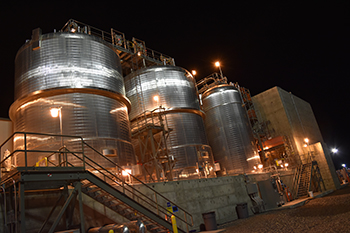Balance of Facilities/Effluent Management Facility
The Vit Plant infrastructure and support facilities are collectively referred to as the Balance of Facilities (BOF) and include the Effluent Management Facility (EMF). The BOF comprises buildings and systems for electrical power distribution, back-up power, compressed air, steam, chilled water, fire water, and communication and control.
Effluent Management Facility
 As part of the Direct-Feed Low-Activity Waste approach, a secondary liquid, called effluent, is generated from the melter off-gas system and when transfer pipes are flushed. These liquids are processed through the Effluent Management Facility, where excess water is evaporated and transferred to Hanford’s nearby Liquid Effluent Retention Facility. The remaining concentrate is sent back into the vitrification process.
As part of the Direct-Feed Low-Activity Waste approach, a secondary liquid, called effluent, is generated from the melter off-gas system and when transfer pipes are flushed. These liquids are processed through the Effluent Management Facility, where excess water is evaporated and transferred to Hanford’s nearby Liquid Effluent Retention Facility. The remaining concentrate is sent back into the vitrification process.
EMF contains three structures: a main processing building, an electrical powerhouse, and a utility systems building.





